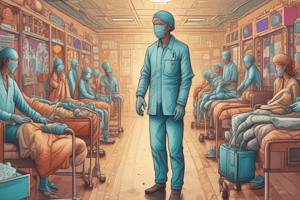Podcast
Questions and Answers
What is the most common cause of bacterial meningitis in infants, young children, and adults in the United States?
What is the most common cause of bacterial meningitis in infants, young children, and adults in the United States?
- Neisseria meningitidis
- Listeria monocytogenes
- Haemophilus influenzae
- Streptococcus pneumoniae (correct)
Which bacteria is known for causing meningococcal meningitis?
Which bacteria is known for causing meningococcal meningitis?
- Listeria monocytogenes
- Streptococcus pneumoniae
- Neisseria meningitidis (correct)
- Haemophilus influenzae
What is meningitis?
What is meningitis?
An inflammation of the membranes (meninges) surrounding the brain and spinal cord.
Acute bacterial meningitis is 100% curable if treated adequately.
Acute bacterial meningitis is 100% curable if treated adequately.
At what age range is the maximum incidence of acute bacterial meningitis observed?
At what age range is the maximum incidence of acute bacterial meningitis observed?
What are common clinical features of acute bacterial meningitis?
What are common clinical features of acute bacterial meningitis?
Acute bacterial meningitis can lead to ___ if not treated appropriately.
Acute bacterial meningitis can lead to ___ if not treated appropriately.
Which of the following is NOT a risk factor for acute bacterial meningitis?
Which of the following is NOT a risk factor for acute bacterial meningitis?
What diagnostic test is crucial for confirming acute bacterial meningitis?
What diagnostic test is crucial for confirming acute bacterial meningitis?
What is the initial action recommended upon suspicion of acute bacterial meningitis?
What is the initial action recommended upon suspicion of acute bacterial meningitis?
Flashcards are hidden until you start studying
Study Notes
Infections of CNS
- Infections can damage nervous tissue through direct injury, microbial toxins, inflammatory responses, or immune-mediated mechanisms.
- Pathogens can enter the nervous system via four main routes: hematogenous spread, direct implantation, local extension, and transport along the peripheral nervous system.
- Hematogenous spread is the most common method, typically through arterial circulation; retrograde venous spread is possible.
- Direct implantation usually involves trauma or congenital malformations.
- Local extension may originate from adjacent structures like air sinuses or infected teeth.
- Certain viruses, such as rabies and herpes zoster, can travel via the peripheral nervous system.
Meningitis
- Meningitis is inflammation of the meninges surrounding the brain and spinal cord.
- Early recognition of CNS infections is vital due to high mortality rates and risk of permanent disability.
- Different forms of meningitis include bacterial, tuberculous, viral meningoencephalitis, brain abscesses, fungal infections, and polio.
Acute Bacterial Meningitis (ABM)
- ABM is a common and serious medical emergency with a high cure rate if treated in time; otherwise, it can be fatal.
- Early diagnosis is critical, typically via CSF examination.
- Major cause of ABM includes Streptococcus pneumoniae, Neisseria meningitidis, Haemophilus influenzae, and Listeria monocytogenes.
Etiology of ABM
- Streptococcus pneumoniae: Most frequent cause of bacterial meningitis in infants and adults, often following pneumonia or sinus infections; vaccine available.
- Neisseria meningitidis: Causes meningococcal meningitis, spread via respiratory infections; outbreaks common in crowded settings; vaccine available.
- Haemophilus influenzae: Once the leading cause in children; vaccination has significantly decreased cases.
- Listeria monocytogenes: Found in unpasteurized foods; affects vulnerable populations, including pregnant women and newborns.
Epidemiology of ABM
- Most cases occur in children under five years old.
- Risk factors include crowding, poverty, male gender, and absence of breastfeeding.
Pathology of ABM
- Pathophysiology involves bacterial colonization leading to bacteremia, affecting the choroid plexus and subsequently the meninges.
- Results in meningeal exudates, encephalitis, and can lead to complications like infarction and increased intracranial pressure (ICP).
Clinical Features of ABM
- Symptoms: Sudden onset of high fever, headache, myalgia, photophobia, and neurological signs (convulsions, stupor, coma).
- Increased ICP may lead to hypertension, bradycardia, bulging fontanelle, and cranial nerve palsies.
- Purpuric rash may indicate meningococcal infection.
Diagnosis and Complications of ABM
- Diagnosed through CSF examination; key indicators include elevated pressure, turbid appearance, increased white cells (primarily neutrophils), high protein levels, and low glucose content.
- Complications may include subdural effusions, empyema, hydrocephalus, and neurological deficits post-infection.
Brain Abscess
- Result from direct implantation of organisms, leading to localized infections in the brain.
Studying That Suits You
Use AI to generate personalized quizzes and flashcards to suit your learning preferences.




